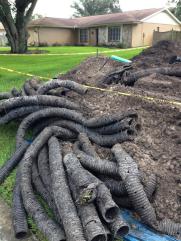This has been the year of the septic system. So far we’ve put in three sets of field lines and had to learn what not to do on a lower pressure drip system. (After owning one for four years, we learned they have a filter that was supposed to be cleaned every six months. Not doing so overpressurized the low pressure system and literally blew holes in the yard. Yay!)
All of our septic system situations started the same way. We got calls saying there was doody in places there shouldn’t be doody. Thankfully, most of it was out in the yard. However, one of the systems found a way to relieve itself under the house. Yuck!
Ashley and I were trying to figure what was going on since there were very few similarities in the properties.

After talking with our septic man Eddie Hilley, we determined that style and age of the house had little to do with the problem. Well – age does play a small factor. Once upon a time field lines were made of corrugated pipe in gravel pits. And as anyone who’s ever buried a drain line for their gutters knows, eventually that black pipe will cave in on itself and clog up.
The industry remedied this problem with a new design called an infiltrator system. Instead of the corrugated pipe, this system used a semicircular chamber that’s 12 inches tall at the center and three feet wide. This makes for an underground cave, if you will, that allows the sewer water to seep back into your yard.

The systems we replaced all had this design – which has a flaw.
The concavity of the infiltrator will eventually flatten out under the weight of the earth. The ones on our properties went from 12 to only six inches in height, thus overwhelming the septic lines.
Theses houses had sat vacant for a few years before we bought them. Since nothing was going down the drain, all the water in the field lines had gone away.
When we buy, we have the septic tank checked out, but there’s no real way to test the field lines. So be aware that if you buy a house that has been vacant for a while, this problem won’t rear its head for a year or more after you get a family in the house using the system to its full capacity.
Therefore, when you buy a house that’s been vacant, plan for extra expenses during the first two years as far as the septic system goes.
Hey that reminds me of a joke:
A congressman was seated next to an attractive young Southern lady on an airplane when he turns to her and says, “Do you want to talk? Flights go quicker if you strike up a conversation with your fellow passenger.”
The woman turns from her book and replies to the total stranger, “What would you want to talk about?”

“Oh, I don’t know,” the congressman says. “How about global warming, universal health care, or stimulus packages?”
He smiled smugly.
“OK,” she says. “Those could be interesting topics but let me ask you a question first. A horse, a cow, and a deer all eat the same stuff – grass. Yet a deer excretes little pellets, while a cow turns out a flat patty, but a horse produces clumps. Why do you suppose that is?”
The legislator, visibly surprised by the Southerner’s response, thinks about it and says, “Hmmm, I have no idea.”
With a country drawl, she replies, “Bless your heart. Do you really feel qualified to discuss global warming, universal health care, or the economy, when it’s obvious you don’t know crap?”
I’m still not sure why those animals excrete differently, but after dealing with these septic systems, I feel I know my crap a little better. Hehe.
Joe and Ashley English buy houses and mobile homes in Northwest Georgia. For more information or to ask a question, go to www.cashflowwithjoe.com or call Joe at 678-986-6813.
